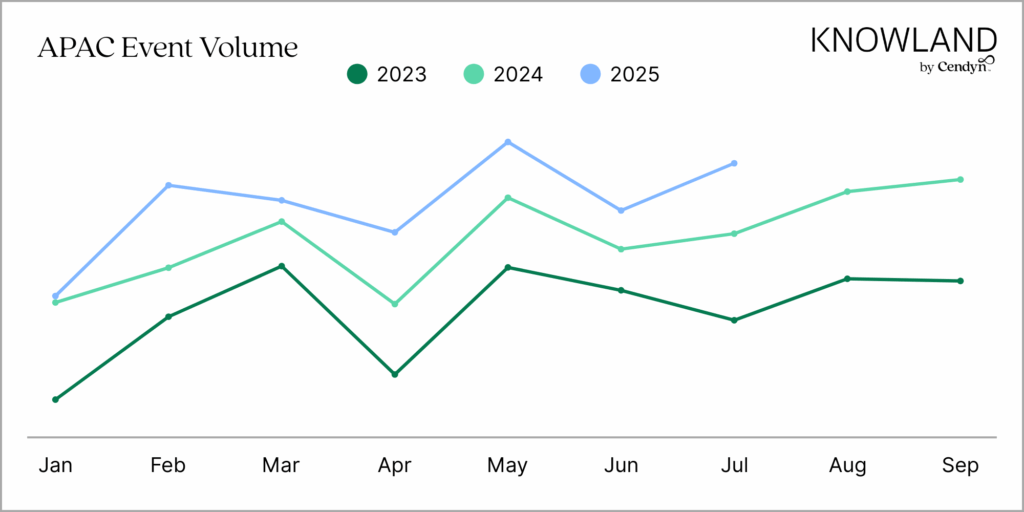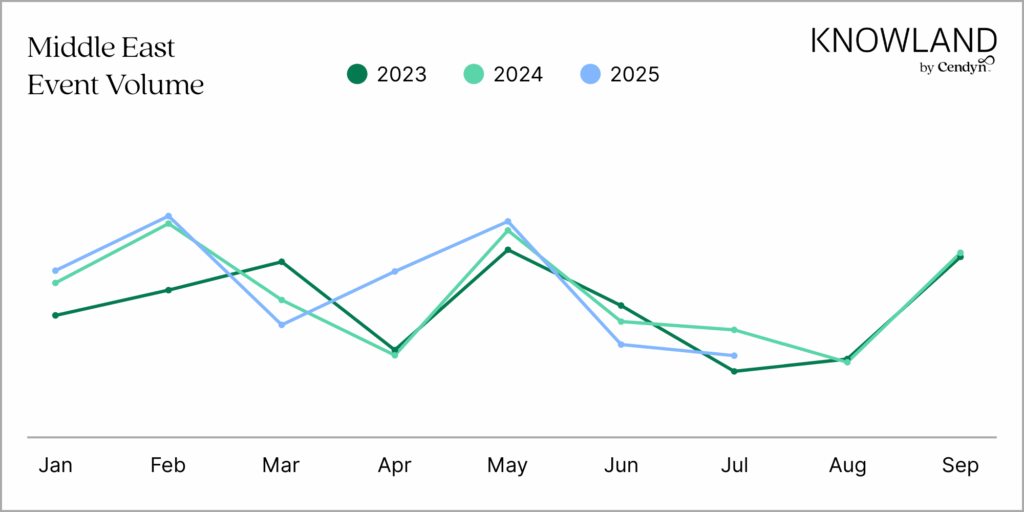

As we move deeper into Q3, the global MICE market continues to show resilience and adaptation across global regions. July 2025 presented some standout trends, including emerging competition in U.S. secondary markets, double-digit growth in APAC, and significant gains in the Middle East.
These insights are powered by Knowland with Cendyn’s July 2025 data, providing a targeted view of global markets so hoteliers can continue adjusting strategies for the season ahead.
United States: Steady growth with secondary markets rising
The United States’ MICE market posted a modest 2.2% overall growth in July 2025, with some compelling trends coming out of secondary markets.
Top 25 Emerging Markets: St. Louis, MO-IL led the charge in July among the Top 25 markets with a compelling 64.2% year-over-year growth. This growth was largely driven by a year-over-year increase in events from Manufacturing, Biotech, and the Financial/Banking industries.
Interestingly, Wisconsin South, which is a secondary market, was very close behind with a notable 61.3% growth, highlighting the increasing significance of non-primary cities in hosting sizable events. This emergence can be traced to a combination of industry and employee factors. For example, Wisconsin South in particular is comprised of several lakefront resorts in areas like the Wisconsin Dells and Lake Geneva. These resorts saw a significant uptick in technology industry events in July, where company meetings included opportunities for the families of attendees to enjoy the resorts’ amenities.
Spotlight: Competition in secondary markets
We also looked at meeting room sizes within the Top 25 markets, and saw an average of 3,870 square feet per meeting, with an estimated group size of 131 attendees.
However, secondary markets were not far behind, averaging 3,625 square feet per meeting and 124 attendees. These numbers are a strong indication that secondary markets in the U.S. can compete with top market cities in terms of meeting space and group size for large-scale events.
Industry Trends: High growth in finance, travel and tech
National Associations continued to dominate the market, showing stability with no year-over-year change. We also saw high growth in certain sectors during July, including Financial/Banking (+ 13.6%), Travel (+12.4%), and Technology (+9.2%). These are encouraging trends, as historically these industries are the first to cut events during times of economic turbulence.
While some industries benefited from significant gains, both Education and Charity/Non-Profit industries saw declines of -6.1% and -4.5% respectively, possibly due to budget constraints from federal funding cuts and potential changes to Non-Profit tax requirements.
U.S. outlook: Strong outlook for fall

If historical patterns hold true, the U.S. MICE market has strong potential for further growth in August and September, with increased activity expected as event planning ramps up for fall conferences.
APAC: Leading the pack with double-digit growth
APAC continues to be the strongest-performing MICE region, recording a substantial 13.8% growth.
Regional standouts: Singapore
Singapore emerged as a clear winner in July with 67.7% year-over-year growth and also reported the highest average meeting size (3,770 square feet) and group size (177 attendees) throughout the entire APAC region.
Other big winners in July include Hong Kong, which saw impressive gains with 20.6% growth followed by Kuala Lumpur with a 6% growth, and Bangkok experiencing modest growth at 2.2%. Australian saw a mixed response with Sydney generating a 9.7% gain, while Melbourne dipped 11.95%.
Industry spotlight: Tech surges ahead
The Technology sector saw explosive growth in APAC of 46.5%, followed by Manufacturing (22.5%) and National Associations (20.1%). Conversely, International Government and Financial/Banking sectors declined 26.7% and 13.3%, respectively.
APAC outlook

Historical data suggests that the APAC region will continue to grow in the coming months, potentially maintaining its lead in the global MICE recovery.
Middle East: Navigating uncertainty with strategic gains
Despite geopolitical uncertainties, the Middle East saw a 4.5% increase in MICE activity in July, with significant gains across the UAE.
Market Highlights: Doha boasts 30% market growth
Overall, markets in UAE which are Dubai and Abu Dhabi showed an optimistic picture with a growth of 19.4% and 13.4% respectively.
Other markets such as Doha stood out with 30% year-over-year growth, signaling robust investment in events infrastructure and corporate travel. In contrast, Riyadh from The Kingdom of Saudi Arabia experienced a significant downturn at -37.3%.
Industry Spotlight: Growth in real estate, finance, and education
In the Middle East, top-performing industries with significant growth, including Real Estate (+54.7%), Financial/Banking (+33.3%), and Education (+20.8%).
Conversely, the most negatively impacted sectors were Travel (-32.6%), International Government (-29.3%), and Technology (-18.6%)
Middle East outlook: Mixed results but continued growth

Despite both gains and losses across the Middle East, this dynamic region maintains a positive trajectory.
Conclusion:
The July 2025 MICE market tells a story of resilience, regional shifts, and evolving industry demands. While APAC takes the lead in growth, the United States is seeing secondary cities emerge as new power players, while the Middle East is cautiously progressing amid geopolitical uncertainties.
As summer ends and we head into fall, commercial teams at hotels and stakeholders should keep an eye on the rise of non-traditional industries, emerging markets, and regional trends that may reshape the event landscape well into 2026.







